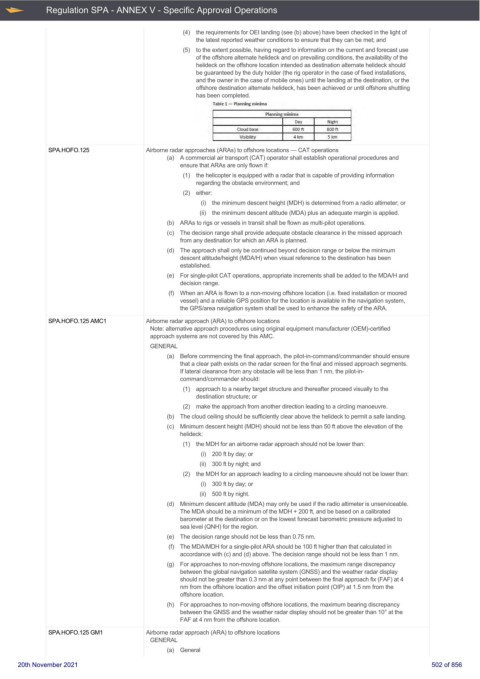Page 502 - UK Air Operations Regulations 201121
P. 502
~
~ Regulation SPA - ANNEX V - Specific Approval Operations Centrik
(4) the requirements for OEI landing (see (b) above) have been checked in the light of
the latest reported weather conditions to ensure that they can be met; and
(5) to the extent possible, having regard to information on the current and forecast use
of the offshore alternate helideck and on prevailing conditions, the availability of the
helideck on the offshore location intended as destination alternate helideck should
be guaranteed by the duty holder (the rig operator in the case of fixed installations,
and the owner in the case of mobile ones) until the landing at the destination, or the
offshore destination alternate helideck, has been achieved or until offshore shuttling
has been completed.
Table 1 - Planning rninima
Planning minima
I Dav I Night
Cloud base 7 600 ft I 800ft
I I
Visibility 4 km 5km
SPA.HOFO.125 Airborne radar approaches (ARAs) to offshore locations — CAT operations
(a) A commercial air transport (CAT) operator shall establish operational procedures and
ensure that ARAs are only flown if:
(1) the helicopter is equipped with a radar that is capable of providing information
regarding the obstacle environment; and
(2) either:
(i) the minimum descent height (MDH) is determined from a radio altimeter; or
(ii) the minimum descent altitude (MDA) plus an adequate margin is applied.
(b) ARAs to rigs or vessels in transit shall be flown as multi-pilot operations.
(c) The decision range shall provide adequate obstacle clearance in the missed approach
from any destination for which an ARA is planned.
(d) The approach shall only be continued beyond decision range or below the minimum
descent altitude/height (MDA/H) when visual reference to the destination has been
established.
(e) For single-pilot CAT operations, appropriate increments shall be added to the MDA/H and
decision range.
(f) When an ARA is flown to a non-moving offshore location (i.e. fixed installation or moored
vessel) and a reliable GPS position for the location is available in the navigation system,
the GPS/area navigation system shall be used to enhance the safety of the ARA.
SPA.HOFO.125 AMC1 Airborne radar approach (ARA) to offshore locations
Note: alternative approach procedures using original equipment manufacturer (OEM)-certified
approach systems are not covered by this AMC.
GENERAL
(a) Before commencing the final approach, the pilot-in-command/commander should ensure
that a clear path exists on the radar screen for the final and missed approach segments.
If lateral clearance from any obstacle will be less than 1 nm, the pilot-in-
command/commander should:
(1) approach to a nearby target structure and thereafter proceed visually to the
destination structure; or
(2) make the approach from another direction leading to a circling manoeuvre.
(b) The cloud ceiling should be sufficiently clear above the helideck to permit a safe landing.
(c) Minimum descent height (MDH) should not be less than 50 ft above the elevation of the
helideck:
(1) the MDH for an airborne radar approach should not be lower than:
(i) 200 ft by day; or
(ii) 300 ft by night; and
(2) the MDH for an approach leading to a circling manoeuvre should not be lower than:
(i) 300 ft by day; or
(ii) 500 ft by night.
(d) Minimum descent altitude (MDA) may only be used if the radio altimeter is unserviceable.
The MDA should be a minimum of the MDH + 200 ft, and be based on a calibrated
barometer at the destination or on the lowest forecast barometric pressure adjusted to
sea level (QNH) for the region.
(e) The decision range should not be less than 0.75 nm.
(f) The MDA/MDH for a single-pilot ARA should be 100 ft higher than that calculated in
accordance with (c) and (d) above. The decision range should not be less than 1 nm.
(g) For approaches to non-moving offshore locations, the maximum range discrepancy
between the global navigation satellite system (GNSS) and the weather radar display
should not be greater than 0.3 nm at any point between the final approach fix (FAF) at 4
nm from the offshore location and the offset initiation point (OIP) at 1.5 nm from the
offshore location.
(h) For approaches to non-moving offshore locations, the maximum bearing discrepancy
between the GNSS and the weather radar display should not be greater than 10° at the
FAF at 4 nm from the offshore location.
SPA.HOFO.125 GM1 Airborne radar approach (ARA) to offshore locations
GENERAL
(a) General
20th November 2021 502 of 856

